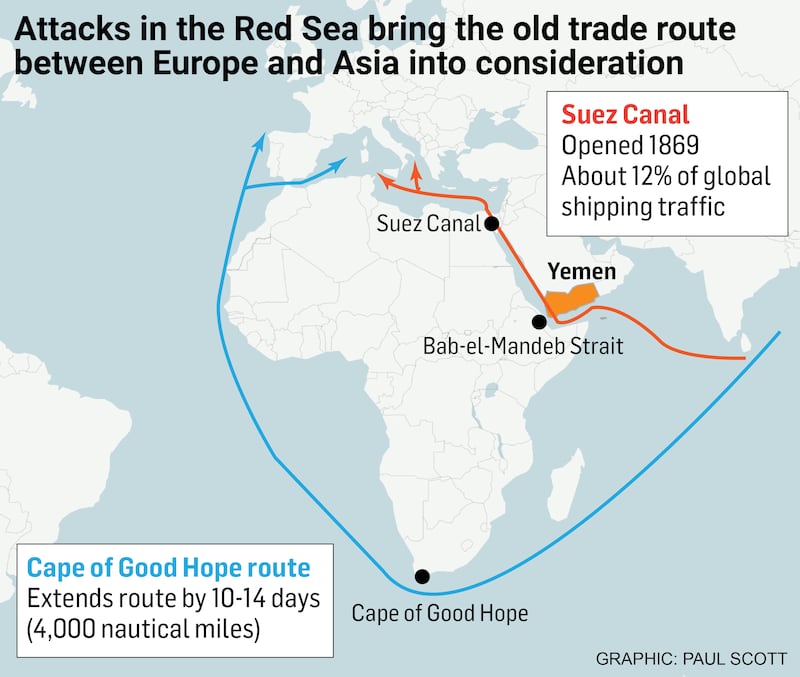Global supply chain problems are starting to look like that bus you might wait ages for, only to see two come along at once.
The first – and most enduring – threat to the carefully calibrated chain that links products from the “world’s factories” in the Far East to Europe and the US was the Covid-19 pandemic that froze international shipping for an extended period in the spring of 2020.
Then there was Russia’s invasion of Ukraine which hit the trade routes from the east hard and brought wheat and sunflower supplies from eastern Europe to a shuddering halt in early 2021.
Next up was the situation – comical, by comparison – where the 400-metre-long Ever Given container ship became lodged in the Suez Canal for days in March 2021. This led to long tail backs in shipping lanes, resulting in hundreds of cargo ships carrying millions of tonnes of products bound for Europe’s shops unable to pass through the canal.
RM Block
There has also been a drought in Central America which has seen the water flowing through the Panama Canal sink to perilously low levels, causing havoc along that key route.
Enduring issues in the South China Sea have raised the spectre of further disruption as the “politics of the sea” continues to be played out along long-standing trade routes.
Supply chains have taken a more serious and sustained hammering since last November when Iran-backed Houthi militia in Yemen launched attacks on ships crossing the Red Sea bound for the Suez Canal. The attacks came in the wake of the Hamas attacks in Israel that left hundreds of civilians dead and the response from the Israelis which has left thousands of Palestinians dead.
As much as 15 per cent of global trade uses the Suez Canal as a short cut from east to west with many shipping companies forced to change course and divert their cargo around South Africa’s Cape of Good Hope as a result of the threat.

The diversions have added between 10 and 14 days to most freight transport by sea and led to inevitable delays in delivery while shipping costs and marine insurance costs have soared.
We certainly don’t anticipate our customers seeing gaps on shelf or any noticeable shortage of product
The impact in some areas was faster than others. Up to 50 per cent of the clothes and shoes worn by Europeans are made in the Far East with the rerouting of container ships leading to companies including Asos, Marks & Spencer, Boohoo and Next to issue warnings over potential delays.
Retailers selling technology made in China have also sounded the alarm.
Furniture retailer Ikea alerted shoppers to potential delays, while car makers Tesla, Volvo and Suzuki have been forced to slow or even halt production in Europe due to a lack of materials.
The fog of war means a clear picture has yet to emerge as to what might happen next, but uncertainty remains certain.
“We have never felt a sequence of events that have been quite so disruptive than over the last four or five years,” said Neal Johnston, a supply chain specialist with consultancy firm EY. “And I think that the geopolitics of the oceans is definitely a factor for the near term.”
He says his clients are “certainly seeing the delayed arrival of goods and the cost increase in freight rates and marine shipping insurance”.
“There have been very significant hikes, in the realm of up to 300 per cent on the cost of a container from Asia into both the Med or northern Europe. I think the consumer will feel it if this continues into the spring which it definitely has the potential to do,” he says.
He suggests that people in the market for new clothes might notice shortages first, although he adds that the first impact of the supply crisis in the Red Sea might be prices creeping up.
“That will depend on the volume of product that can be loaded on to cargo ships while the margin in a business will also be key. Very good margin businesses will be able to [absorb] higher transport costs, but there will be others who would like to pass it on,” he says.
The people at clothes retailer Penneys are upbeat, or at least not overly downbeat about the impact on shoppers.
“In the near term we don’t anticipate significant disruption,” a spokeswoman said.
“We have a resilient supply chain which has responded well to the challenges of recent years. Ships are currently being rerouted via the Cape of Good Hope, which adds about 10-14 days to the journey, but we have good stock levels. We certainly don’t anticipate our customers seeing gaps on shelf or any noticeable shortage of product.”
Containers rely on a just-in-time delivery system and we are dependent on those containers moving freely
Prolonged unrest in the Gulf region could pose greater complications.
“If the conflict in the Middle East is not resolved in the short term, then we could start to see gaps on the shelves and prices rising within three months,” said Damian O’Reilly, a lecturer in retail management at Technological University (TU) Dublin.
“In the short term what you are going to see is two or three key impacts,” said Mark McKeever, a director at consultants PwC Ireland.
“If you are going from Shanghai to northern Europe, the cost of a container has gone from around €1,400 to €4,900, so that is quite a significant increase, but if I put that in context, during peak Covid that container would have cost €14,000.
“Clothes retailers would have between 12 and 15 weeks’ worth of stock in warehouses already, so it is not an issue, but if this was prolonged that might change,” he said.
“We are not at peak demand right now, but if this continues and we head into peak demand from August to November then it becomes very serious.”
In addition to supply chain issues, extended trade disruption could see inflation remain higher than expected and derail anticipated moves by the European Central Bank to start cutting interest rates this year.
Using an International Monetary Fund (IMF) estimate of the impact of higher freight costs on inflation, Oxford Economics said it could add 0.6 percentage points to inflation in a year’s time. The ECB is expecting euro zone inflation to fall from 5.4 per cent in 2023 to 2.7 per cent this year, so a 0.6 per cent change could make a substantial difference.
“While this suggests that a sustained closure of the Red Sea wouldn’t prevent inflation from falling, it would slow the speed at which it returns to normal,” Oxford Economics said.
In the longer term, the situation may encourage companies to push ahead with pandemic plans for alternative, more predictable supply routes, a process known as “near-shoring” to bring production closer to key markets.
A standard white T-shirt might continue to be produced in China because a retailer can easily assess exactly how many they will sell in a year and plan according, but for more seasonal trend-driven stock, it might be manufactured in Portugal, Morocco, Turkey, Spain or even Ireland.
Whatever options are explored, the likelihood is that they all have one thing in common: higher costs.
The delays in shipping have had an immediate impact closer to home too.
In Panda Waste’s enormous recycling facility in Dublin this week bales of aluminium, cardboard and plastic were tied up and waiting to be collected and shipped to Europe for recycling.
“We move a lot of material in containers out of Dublin Port,” says David Tobin of Panda.
“The paper and cardboard could go to a paper mill in Finland, the aluminium might go to Norway or Sweden for smelting, but it’s all about moving containers, so issues like the Suez Canal or the Red Sea creates a blockage.
“Containers rely on a just-in-time delivery system and we are dependent on those containers moving freely. So it has a knock-on effect everywhere. We will just have to wait and see what happens, like everyone else.”
- Sign up for push alerts and have the best news, analysis and comment delivered directly to your phone
- Find The Irish Times on WhatsApp and stay up to date
- Our In The News podcast is now published daily – Find the latest episode here



















